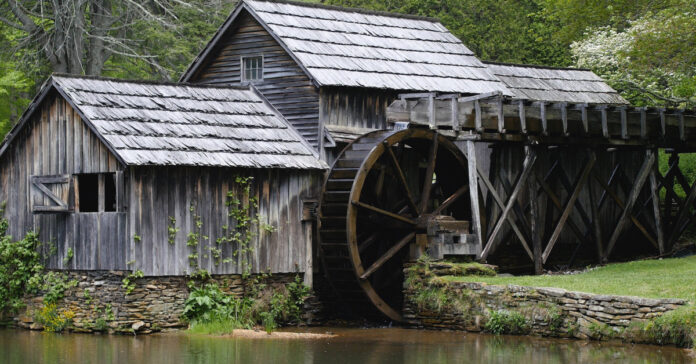
I’ve considered solar power, both for emergency use and for regular use, but determined a large system to be outside my price range. After mentioning micro hydropower in yesterday’s post, I did some research and determined that it could work on our land. I’ll go into some details below as well as discuss how it compares to solar for preppers or anyone living off grid.
Like solar, hydropower is not inexpensive. It requires much of the same equipment solar power does, including a battery bank, inverter, and cabling. If there is a long cable run from the turbine to your house, additional equipment may be needed along with a waterproof housing or other shelter to house the electronic equipment.
Sites for Hydropower
To use water to turn a turbine and produce power, you must either have lots of water, fast moving water, or a combination of the two. There are three sites on our property that appear suitable for one or more of the hydropower turbines sold by PowerSpout, a supplier I found online. Let’s look at the water flow and the pluses and minuses of each.
Site 1
This location has a 64 foot fall over 310 feet in distance. I took the reading on an altimeter app on my phone while I was walking the dog. Then I came inside and confirmed it, using the contours on a map I accessed via my computer. The app was quite accurate, much to my surprise.
The pluses are that this is close to the house, so I could easily access both the intake, to clean it out for example, and the turbine. It is also near the road, making it easy to bring in equipment.
The minus is that the turbine would be visible from the road, meaning someone could mess with it. My understanding is that turbines are noisy, so another minus is that we might hear it. It might overwhelm the running water sound we enjoy now.
Site 2
This has about the same fall as site 1, but over a much longer distance, 525 feet. Because of this, it will be more expensive and less efficient. I’m crossing it off the list.
Site 3
This is a stream going straight down a steep part of the mountain. It has a fall of up to 260 feet over some 1,000 feet. Because we could put the intake wherever we wanted, it could be 200 feet of fall over 800 feet or 100 feet of fall over 400 feet. That kind of head sounds like it has some good potential.
The downside is that this is not near the house, would require a larger investment in pipe, and does not have as much water as the other two. Still, with that kind of head, the volume of water per second is less important. The biggest challenge of this site is the difficulty of reaching it. It might require some road making and if I were to service it regularly, I’d want a side-by-side or a four-wheelers. (Hey, if I’m going to dream, why not dream big?)
Volume or Flow
While measuring the head, or distance the water falls, is pretty straight forward, measuring the volume of water in a stream is more difficult. All of these streams flow fast enough that holding a 5-gallon pail under the flow would fill it up in a manner of seconds. If we say three seconds, then that’s 100 gallons per minute, or 1.67 gallons per second, which is more than six liters per second. I’m guessing that Stream 1 is a little faster than that and Stream 3 is a little slower, but I have not tested this theory. PowerSpout provides a testing method which I may try where Stream 1 goes through a culvert.
On the other hand, it we the bucket get filled in two seconds, then its 150 gallons a minute, which is 2.5 gallons per second, about 9.5 liters. That could change the equation.
It’s also worth noting that the water level and flow is high right now. For example, the rock I often stand on when the dog gets her drink in the creek is underwater. We don’t get this much flow in the middle of summer, which tends to be drier. Our water levels can vary based on how much rain we have had, when, and for how long. Do I design a system for our minimum water volume or maximum throughput? I expect some happy medium will be the most efficient.
Solar Versus Hydro
If I already had a solar system and had invested in a battery bank, fuses, shunts, meters, and an inverter, adding hydropower would be an easy decision. Even a small system that made just 500 watts per hour would keep us from needing to use the generator on cloudy days by pumping 12 kilowatt hours into the battery bank. That continuous production is an advantage of hydropower over solar or wind power.
If I had to choose between the two, knowing what I know and not knowing what I don’t know, I would probably go with solar because it is more self-contained and easier to install. I can put solar on my roof and run wires into my basement. A hydropower system requires more infrastructure and some of that infrastructure could be in places difficult to reach.
Solar is also easier to start small and build in phases. For example, I could buy four 300 watt panels today and then, in a year, add four or eight more. I could start with a single inverter to provide 120 volt power and add a second to give us 240 after I get more panels. In our setting, hydropower production would be difficult to expand.
I think the best bet would be to have both. Solar works best in the summer when we get less rain and hydro works best in the winter when we have less sun. This would also give us redundant sources of power every day except those in the single digits where we might have to shut down the hydropower system to prevent damage from frozen pipes.
Not Anytime Soon
If I was building a house a mile or two from the nearest power pole, installing a hydropower system might seem like a bargain compared to the cost of bringing a new electric service to the site, but since our home is already served by the local utility, that’s not the case.
While getting a small solar generator is within the realm of possibility, getting a large solar or hydropower system with a battery bank that can hold 25 or 30 kilowatt hours is not on the radar for us. For financial reasons, it remains out of reach. Solar panel prices have dropped, however, as have battery prices. I’m afraid the government’s push for more electric vehicles will increase demand for lithium batteries and the resulting scarcity will drive the price up, but time will tell. Maybe the day will come where volume production will drive down the pricing.
In the meantime, I’ll keep researching. There are plenty of other vendors out there. Just don’t expect me to buy one directly from China.






